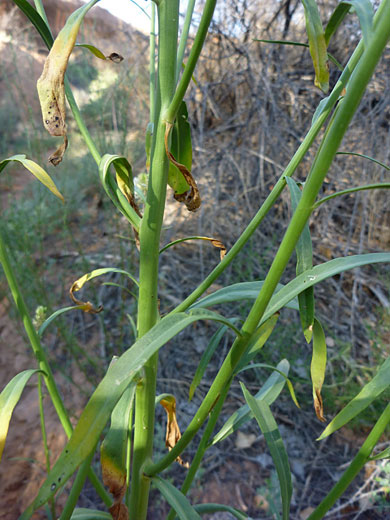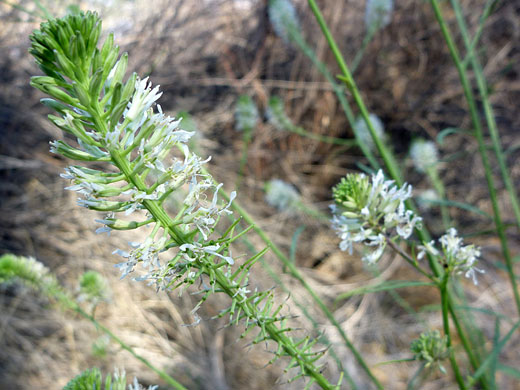Thelypodium Integrifolium, Entireleaved Thelypody
Plants > Wildflowers > Brassicaceae > Thelypodium Integrifolium
Common name:
Entireleaved thelypody
Family:
Scientific name:
Thelypodium integrifolium
Main flower color:
Range:
From the Great Basin to the Rocky Mountains, and small areas of adjacent states
Height:
Up to 9 feet, but 5 feet is more typical
Habitat:
Desert flats, canyons, scrubland, alkaline and mineralized areas
Leaves:
Lanceolate to oblong to spatulate, up to 12 inches long
Season:
June to September
Stems of thelypodium integrifolium are thick, hairless, ribbed and rigid, sometimes reaching a height of 9 feet. Stems and leaves have a waxy surface texture. Basal leaves are somewhat variable in shape, but always long and relatively thin; they grow on stalks, and usually have entire edges. Stem leaves are stalkless and more linear in shape. Stems may be single or branch a few times towards the top, each terminating in an elongated cluster, the flowerheads borne on short green stalklets at right angles to the main stem. Flowers tend to have a somewhat ragged appearance; they have 4 pointed green sepals, 4 white or pale purple petals and protruding, purplish anthers. Flowers are followed by long, thin green fruits, often visible at the lower end of the cluster while the top end is still blooming.
There are five subspecies (affine, longicarpum, integrifolium, complanatum, gracilipes), differing in such aspects as petal color, petal size, fruit characteristics and the length of the stalklets holding each flower.
There are five subspecies (affine, longicarpum, integrifolium, complanatum, gracilipes), differing in such aspects as petal color, petal size, fruit characteristics and the length of the stalklets holding each flower.
All Contents © Copyright The American Southwest | Comments and Questions | Contribute | Site Map



